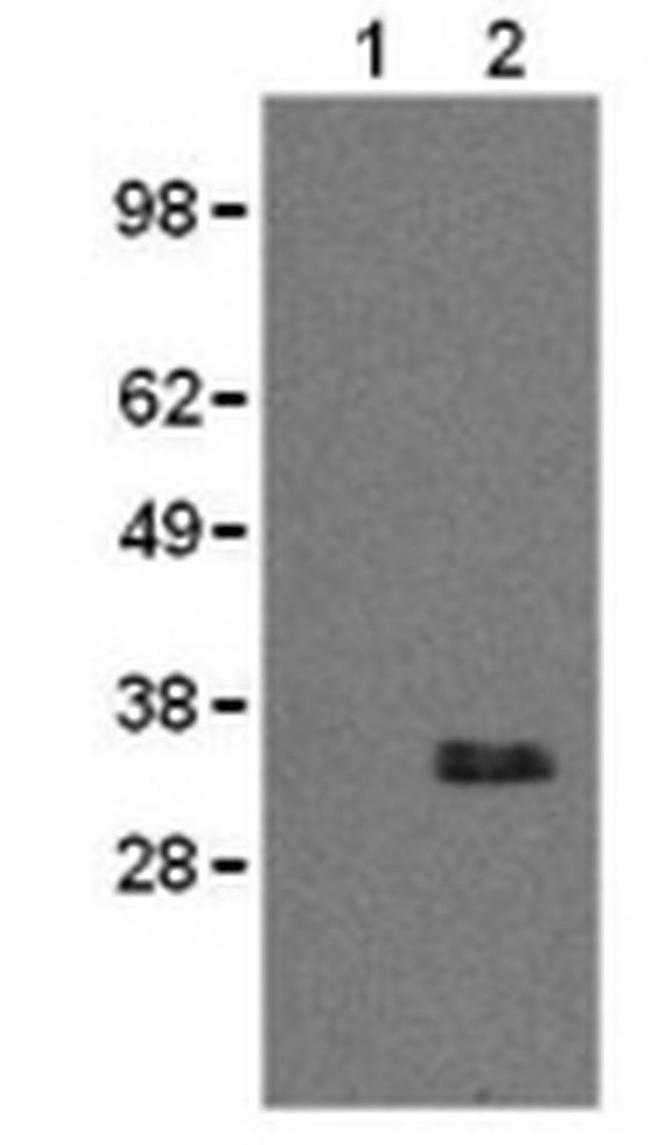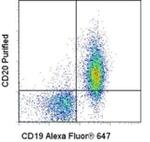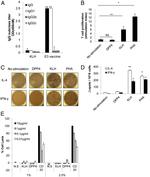Search Thermo Fisher Scientific
Invitrogen
CD20 Monoclonal Antibody (AISB12), Functional Grade, eBioscience™
Product Details
16-0201-82
Species Reactivity
Published species
Host/Isotype
Recommended Isotype Control
Class
Type
Clone
Conjugate
Form
Concentration
Purification
Storage buffer
Contains
Storage conditions
Shipping conditions
RRID
Product Specific Information
Description: The AISB12 monoclonal antibody reacts with mouse CD20. CD20 is a B cell-specific 32kDa membrane protein involved in intracellular calcium regulation. CD20 expression begins after the induction of CD19 during development, and is coexpressed with IgM during the pre-B to immature B cell transition in bone marrow. Expression then increases during maturation with almost all mature cells expressing some level of CD20. The human CD20 antigen has proven to be an effective immunotherapeutic target in B cell lymphoma and several autoimmune diseases including rheumatoid arthritis and type I diabetes. CD20 consists of 4 transmembrane domains and a 44 amino acid extracellular loop domain where AISB12 binds.
Applications Reported: This AISB12 antibody has been reported for use in flow cytometric analysis, western blotting and functional assays.
Applications Tested: This AISB12 antibody has been tested by flow cytometric analysis of mouse splenocytes. This can be used at less than or equal to 0.25 µg per test. A test is defined as the amount (µg) of antibody that will stain a cell sample in a final volume of 100 µL. Cell number should be determined empirically but can range from 10^5 to 10^8 cells/test. It is recommended that the antibody be carefully titrated for optimal performance in the assay of interest.
Storage and handling: Use in a sterile environment.
Filtration: 0.2 µm post-manufacturing filtered.
Purity: Greater than 90%, as determined by SDS-PAGE.
Endotoxin Level: Less than 0.001 ng/µg antibody, as determined by LAL assay.
Aggregation: Less than 10%, as determined by HPLC.
Target Information
CD20 is a non-glycosylated surface phosphoprotein that has a molecular weight range of 33-37 kDa depending on the degree of phosphorylation. CD20 is expressed on mature and most malignant B cells, in a subpopulation of T lymphocytes and follicular dendritic cells. CD20 expression on B cells is synchronous with the expression of surface IgM and it regulates transmembrane calcium conductance, cell cycle progression and B-cell proliferation. CD20 is also associated with lipid rafts, but the intensity of this association depends on extracellular triggering, employing CD20 conformational change, and/or BCR (B cell antigen receptor) aggregation. After the receptor ligation, BCR and CD20 colocalize and then rapidly dissociate before BCR endocytosis, whereas CD20 remains at the cell surface. CD20 serves as a useful target for antibody-mediated therapeutic depletion of B cells, as it is expressed at high levels on most B-cell malignancies, but does not become internalized or shed from the plasma membrane following monoclonal antibody treatment. Diseases associated with CD20 dysfunction include Ms4a1-related common variable immune deficiency.
For Research Use Only. Not for use in diagnostic procedures. Not for resale without express authorization.
Bioinformatics
Protein Aliases: APY; ATOPY; B-cell differentiation antigen Ly-44; B-lymphocyte antigen CD20; CD20; CD20 antigen; Fc epsilon receptor I beta chain; Fc Fragment of IgE high affinity I receptor for beta polypeptide; FCER1B; IGEL; IGER; IGHER; LEU16; Ly44; Lymphocyte antigen 44; Membrane-spanning 4-domains subfamily A member 1; membrane-spanning 4-domains, subfamily A, member 2; MGC3969
Gene Aliases: AA960661; Cd20; Ly-44; Ms4a1; Ms4a2
UniProt ID: (Mouse) P19437
Entrez Gene ID: (Mouse) 12482

Performance Guarantee
If an Invitrogen™ antibody doesn't perform as described on our website or datasheet,we'll replace the product at no cost to you, or provide you with a credit for a future purchase.*
Learn more
We're here to help
Get expert recommendations for common problems or connect directly with an on staff expert for technical assistance related to applications, equipment and general product use.
Contact tech support



